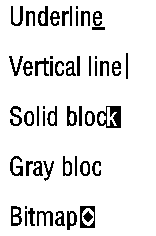
Windows forms a caret by inverting the pixel color within the rectangle given by the caret's position, width, and height. Windows flashes the caret by alternately inverting the display and restoring it to its previous appearance. The caret's flash rate, in milliseconds, defines the elapsed time between inverting and restoring the display. A complete flash (on-off-on) takes twice the blink time.
The CreateCaret function creates the caret shape and assigns ownership of the caret to the given window. The caret can vary in color and shape; a bitmap caret can be given any pattern. The following illustration shows some typical variations in the appearance of the caret.

Windows displays a solid caret by inverting everything in the rectangle defined by the caret's width and height. For a gray caret, Windows inverts every other pixel. For a pattern, Windows inverts only the white bits of the bitmap that defines the pattern. The width and height of a caret are given in logical units, which means they are subject to the window's mapping mode.